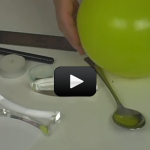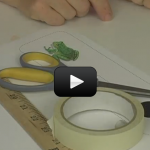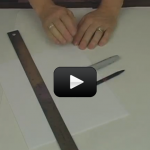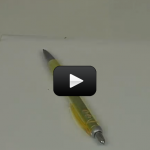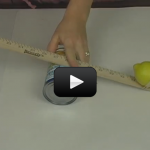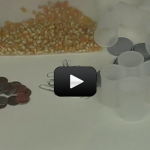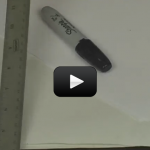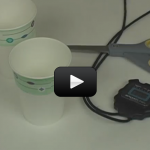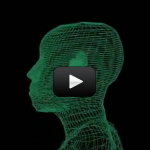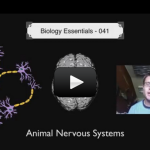Eyeballoon
In this lab, we are going to make an eyeball model using a balloon. This experiment should give you a better idea of how your eyes work. The way your brain actually sees things is still a mystery, but using the balloon we can get a good working model of how light gets to your … Continue reading "Eyeballoon" |
Water Lens
Like sound, light travels in waves. These waves of light enter your eyes through the pupil, which is the small black dot right in the center of your colored iris. Your lens bends and focuses the light that enters your eye. In this experiment, we will study this process of bending light and we will … Continue reading "Water Lens" |
Disappearing Frog Experiment
Your optic nerve can be thought of as a data cord that is plugged in to each eye and connects them to your brain. The area where the nerve connects to the back of your eye creates a blind spot. There are no receptors in this area at all and if something is in that … Continue reading "Disappearing Frog Experiment" |
How Does the Eye Work?
The eye is a complex structure that detects and focuses light. Light first enters the eye through the cornea, a clear protective layer on the outside of the eye. The pupil, a black opening in the eye, lets light in. In dark rooms, the pupil will become larger, or dilate, in order to let in … Continue reading "How Does the Eye Work?" |
Visual Reflex
Voluntary nerves are the ones that are under our direct control. Others, called involuntary nerves, are under the control of our brains and create involuntary reactions. |
PhotoReading
Does it sound impossible to read 25,000 words per minute with a 75% comprehension? Not at all! I learned how to photoread using this cool technique developed by Paul Scheele that I am going to share with you. You’ll be able to digest entire textbooks, articles and newspapers that have been piling up, or read … Continue reading "PhotoReading" |
Camera Eyes
Your eyes have two different light receptors located on the back of the eyeball. These are the rods, which see black, white and grays, and the cones, which see color. In order to adapt to the dark, our eyes make a chemical called visual purple. This helps the rods to see and transmit what you … Continue reading "Camera Eyes" |
Human Levers
Levers are classified into three types: first class, second class, or third class. Their class is identified by the location of the load, the force moving the load, and the fulcrum. In this activity, you will learn about the types of levers and then use your body to make each type. |
Sound Speed
Sound has the ability to travel through the states of matter: solids, liquids, and gases. In this experiment we will study the movement of sound through these three states. |
Sound Matching
You know that sound comes from vibration which are picked up by the pinna (external part of the ears). Then the vibrations vibrate your tympanic membrane, which in turn vibrates the ossicles and then the cochlea. The cochlea sends information through the auditory nerve and sends it to the brain, which recognizes it as sound. … Continue reading "Sound Matching" |
Sound Whackers
Have you ever held a plastic ruler over the edge of a desk or table and whacked the end of it? If so, you would notice a funny sound. This sound changes if you change the length of the ruler that is hanging over the edge. The sound you hear is made by the ruler’s … Continue reading "Sound Whackers" |
Big Ears
How do you think animals know we’re around long before they see us? Sure, most have a powerful sense of smell, but they can also hear us first. In this activity, we are going to simulate enhanced tympanic membranes (or ear drums) by attaching styrofoam cups to your ears. This will increase the number of … Continue reading "Big Ears" |
Ewww… Earwax!
It may seem like walking across a balance beam and listening to your favorite song are very different activities, but they both depend on your ears. Ears are the sense organs that control hearing, which is the ability to detect sound. Ears also sense the position of the body and help maintain balance when you … Continue reading "Ewww… Earwax!" |
How Your Brain Feels Pain
Your body is made of organs, like your heart, lungs or stomach. These organs work together to allow you to breathe, eat, move, and do just about everything else you need to do. Organs working together are called organ systems. Although all organ systems are important, and necessary for us to survive, the most important … Continue reading "How Your Brain Feels Pain" |
Nerve Tester
Our sense of touch provides us with information that helps us to process and explore our world. Nerves play an important part in the sense of touch by being the wires that carry signals from the skin to the brain. But the body has a plan in place so that our brains don’t get overwhelmed … Continue reading "Nerve Tester" |
Positive and Negative Feedback Loops
Our cells are happiest when they are in their normal or “home” state. This is a state in which the temperature, the concentrations of molecules, and molecules being produced are all at the levels at which they normally function. This “normal” or “home” state is called homeostasis. Our cells—and the tissues and organs they constitute—work … Continue reading "Positive and Negative Feedback Loops" |

